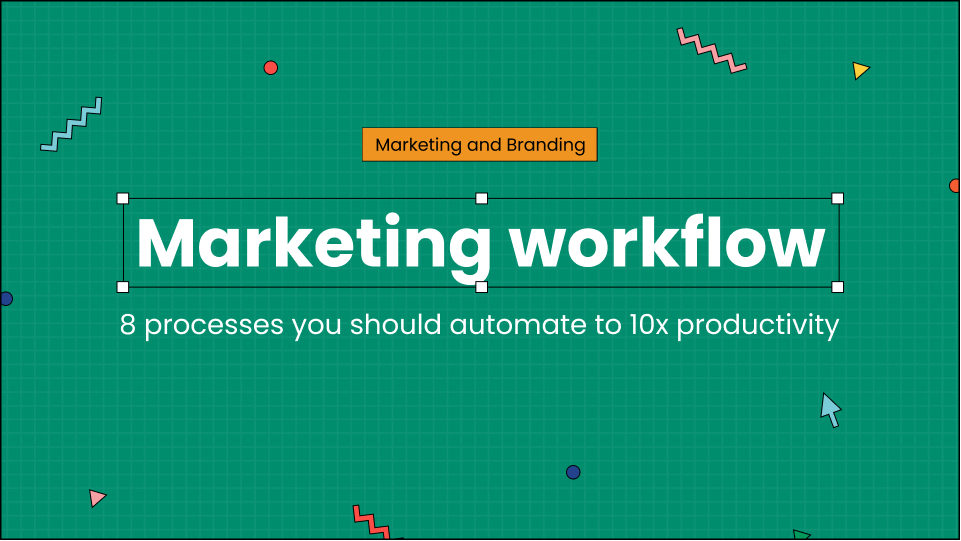Have you ever tried to promote a product or service and felt overwhelmed by all the tasks you had to do?
There are so many things to do that it can get overwhelming! You have to create content, send emails, and manage social media. All of these tasks are part of what we call a marketing workflow.
This article explores everything you need to know about the marketing workflow, how to automate marketing workflow, and lastly, 8 things to automate for success. So, keep on reading to learn the best marketing workflow tactics.
Let’s begin!
Table of Contents
What is marketing workflow?
A marketing workflow is a series of steps a marketing team follows to create and run a campaign.
The idea is to ensure that everyone on the team knows what they need to do and when they need to do it. Automating certain tasks in marketing workflow can save ample time, reduce mistakes, and produce better results.
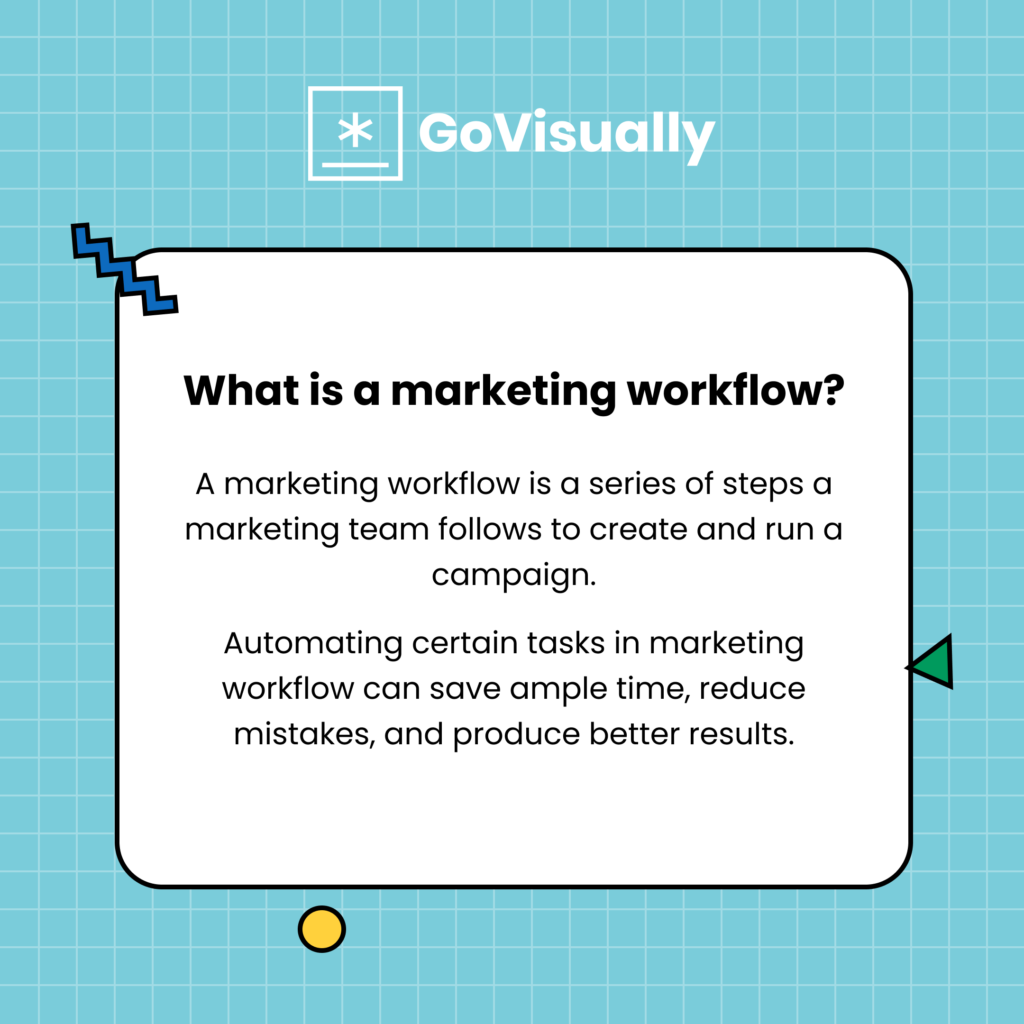
For instance, instead of spending hours sending the same email to every team member, you can take the help of technology to send personalized emails to each team member. This is what it’s called to automate marketing workflow.
3 key reasons you need a marketing workflow
As a marketer, projects can get messy quickly if you don’t have a plan. That’s where marketing workflows come in. These structured processes help keep everyone on track and ensure that projects move smoothly from start to finish.
Here are a few reasons why you need marketing workflows for your next project:
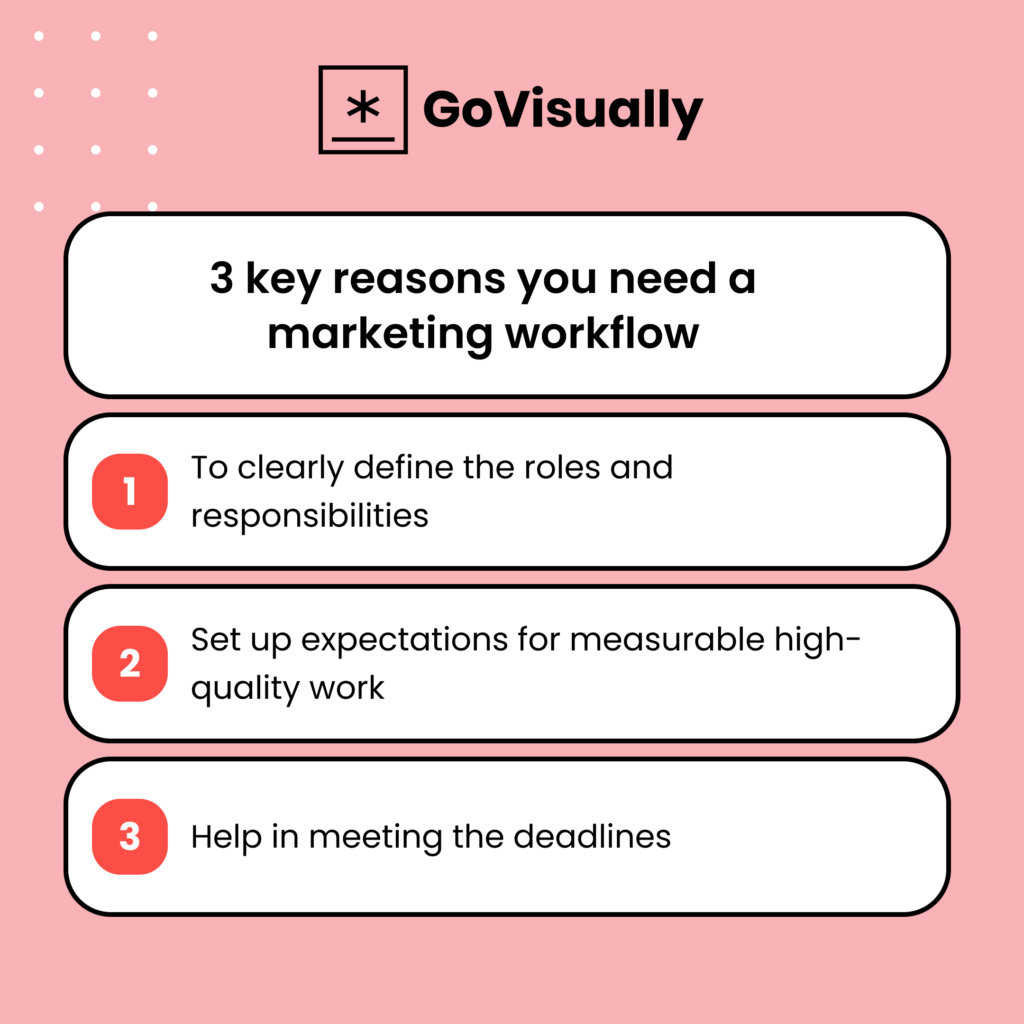
1. To clearly define the roles and responsibilities
Have you ever worked on a project with several team members?
Roles and responsibilities can easily clash, leading to wasted time and resources. A clear marketing workflow helps eliminate overlapping and duplication of work by specifying all tasks explicitly.
It can feel very frustrating, right?
With a well-defined marketing workflow, everyone knows exactly what to do and when. This helps improve team alignment and ensures everyone works towards the same goal.
Let’s say you’re launching a new product. Your marketing workflow might include creating a landing page, developing email campaigns, and setting up social media ads. Each team member knows exactly which tasks they’re responsible for and when they need to be completed.
2. Set up expectations for measurable high-quality work
When projects get chaotic, it’s easy for things to go awry. That’s why marketing workflows are so important. They help ensure that tasks are completed on time and have high quality.
By prioritizing tasks and establishing task dependencies, you can control the consistency and quality of your projects.
Moreover, every marketer wants their marketing campaigns to be successful. The only way you can achieve this is by mapping a marketing workflow!
A clear marketing workflow helps you achieve that by improving coordination and ensuring timely project completion. Keeping track of progress and identifying obstacles is crucial to successful marketing campaigns.
3. Help in meeting the deadlines
How can you ensure that you meet those deadlines without sacrificing the quality of the projects? By setting up a marketing workflow!
A well-defined workflow helps you define the project timeline from the start. This enables team members to maintain their pace throughout the project’s lifecycle. Ultimately, it leads to faster project execution and more time to spare for any revisions.
For example, you’re running a social media campaign. Your marketing workflow might include creating a content calendar and scheduling posts. Setting up task dependencies and deadlines ensures your campaign is launched on time and successfully.
How to create a marketing workflow?
As a business owner or marketer, you know how important it is to get your marketing right. But with so many different tasks and channels to manage, it can be hard to know where to start.
That’s where optimizing your marketing workflow comes in; it can save you time, improve efficiency, and ultimately increase your revenue.
1. Organize the tasks
The first thing that you need to do is plan and organize your marketing tasks. This means figuring out what needs to be done, when it needs to be done, and who’s responsible for doing it.
Creating a solid marketing plan, using project management tools, setting deadlines, and assigning tasks to team members can help you stay on track.
2. Automate repetitive tasks
Another way to save time is by automating repetitive tasks. Scheduling social media posts, sending email campaigns, and tracking analytics are just a few examples of tasks that can be automated. This frees you up to focus on more important tasks.
3. Communicate
Marketing is not a solo endeavor. It involves multiple team members. Therefore, effective collaboration is key to a successful campaign. Collaboration tools and establishing a clear approval process are ways to ensure everyone is on the same page and working towards the same goals.
A sneak peek into GoVisually’s content workflow automation
At GoVisually, we swear and work by automating workflows!
So one of the ways we manage our content creation process for the blog is by using the Asana board. We have a Kanban board set up on Asana with distinct categories to identify the work stage.
Here’s a screenshot of the categories we use for our blog content.
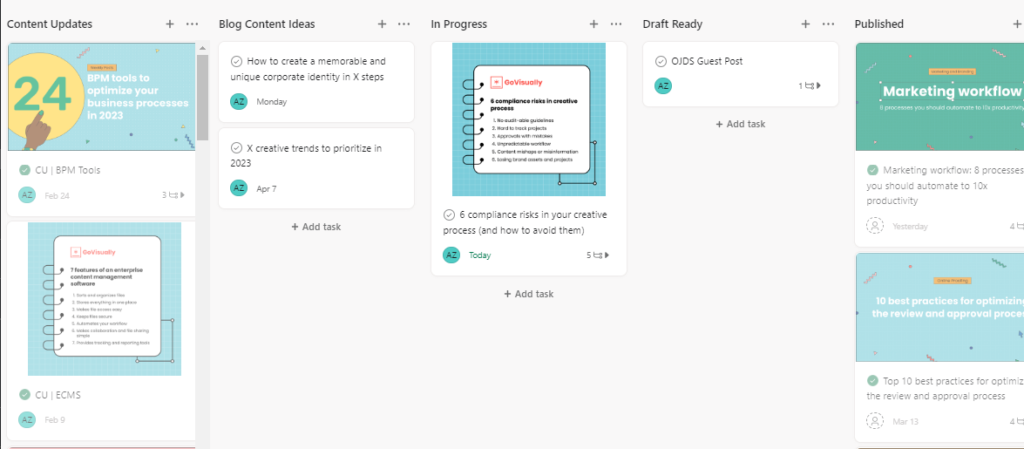
Notice how it’s simple, easy, and quick to digest. The idea is that automation should be easy. Remember, it’s to simplify your work process, not overcomplicate it.
Each task has a detailed description of who it’s assigned to, the due date, and other relevant details for completion. Using these columns, we can easily keep tabs on the progress of each task.
So if you want to automate your content creation process, I’d advise you to start with a simple board like this to keep track.
How to automate marketing workflow?
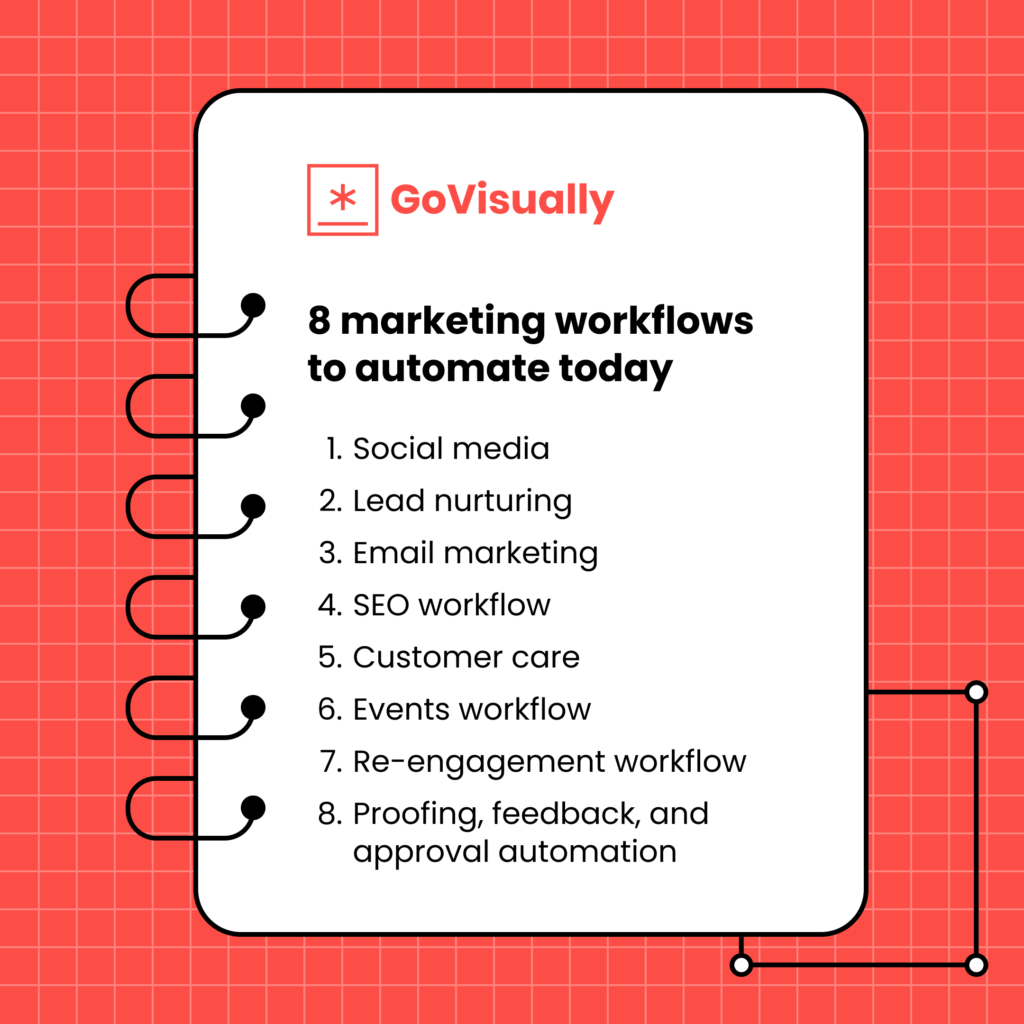
1. Social media
Social media has become an essential part of any marketing strategy. However, posting consistently on multiple platforms can be daunting and time-consuming. This is where automation can be a game-changer.
Here are some social media posting tasks that you can automate for a better marketing workflow:
Scheduling
Scheduling social media posts in advance can save you significant time. With tools like Hootsuite, Buffer, or Sprout Social, you can schedule posts for multiple platforms, set the posting time and date, and even preview how your posts will look before they go live.
Repurposing content
Repurposing old content is an excellent way to keep your social media channels active without constantly creating new content.
Hashtag research
Hashtags are essential for social media success, but researching them can be time-consuming. Tools like Hashtagify or RiteTag can help you find relevant hashtags for your industry and automatically suggest them for your posts.
Content curation
Sharing third-party content relevant to your industry is a great way to get noticed and provide value to your audience. Several tools like Feedly or Pocket can help you curate content and automatically share it on your social media channels.
Analytics
Tracking social media performance is crucial for understanding what works and doesn’t for your business. Tools like Sprout Social or Hootsuite provide detailed analytics on your social media channels.
2. Lead nurturing
Lead nurturing is a crucial part of the marketing process. This is because it helps to build relationships with potential customers and guide them through the sales funnel. However, manually nurturing leads can be time-consuming and cost you more effort than necessary. That’s where automation comes in.
By automating your lead nurturing process, you can save time and ensure that your leads receive the attention they need to convert into customers eventually. You can use lead nurturing tools like HubSpot, Pardot, Active Campaign, etc., to help you with the task.
As many as 80% of marketers reported getting more leads using marketing automation software.
Here are a few ways you can automate your lead nurturing process:
Use targeted email campaigns
Set up automated email campaigns triggered by your leads’ specific actions or behaviors, such as downloading a whitepaper or filling out a contact form. This ensures that your leads receive relevant content that meets their interests and needs.
Implement lead scoring
Lead scoring assigns a numerical value to each lead based on their behavior and interactions with your brand. Automating this process allows you to easily identify the most qualified leads and be ready for further engagement.
Send personalized content
Personalized content is more effective at engaging and converting leads than generic content.
Use chatbots
Web chatbots are a great way to automate lead nurturing by responding immediately to common questions and inquiries.
3. Email marketing
Email marketing is an excellent way to connect with your audience and encourage them to take action, but it can be time-consuming and tricky to manage manually. Automation tools can streamline the process and save time while sending personalized and targeted messages to your subscribers.
Here are some tips to help you automate your email marketing workflow:
Welcome emails
Send a friendly and personalized welcome email automatically to new subscribers after signing up. This helps establish a connection with your audience.
Abandoned cart emails
Send an automatic email to customers who leave items in their online shopping cart without completing the purchase. This reminder can help recover lost sales and increase revenue.
Birthday or anniversary emails
Celebrate your subscribers’ special occasions by sending an automated email that offers a personalized discount or promotion. This can help build loyalty and increase customer retention.
Re-engagement campaigns
If a subscriber hasn’t opened or clicked on your emails in a while, send an automated re-engagement campaign to try and win them back. This could include a special offer or incentive to encourage them to take action.
A/B testing
Use automation tools to test different subject lines, email content, and calls-to-action to see which performs better with your audience. This can help you optimize your email campaigns for better results.
4. SEO workflow
If you want people to find your website, you need to make sure that the website appears at the top of search results.
Here are some ways to make your website more SEO friendly:
Keyword research
Many apps like Google Keyword Planner, Ahrefs, or SEMrush can help you find the right keywords. Using the right keywords can help you create content that matches the needs of your target audience.
Make it mobile–friendly
Once you have the right keywords, ensure your website is easy for search engines to understand. That means ensuring your website is structured correctly. You also want to ensure your website loads quickly and works well on all devices, like phones and tablets.
Master the art of linking
Linking is another way you can amp up your SEO! All you have to do is ensure other websites link back to your website. This tells search engines that your website is important and relevant, so they’ll be more likely to show it in search results.
Create engaging content
Creating valuable and engaging content on your website is also important. That could mean blog posts, videos, infographics, or other content your target audience finds useful.
Track analytics
It’s important to keep track of how your SEO efforts are working. You can use tools like Google Analytics, Search Console, or SEMrush to monitor your website traffic, keyword rankings, and backlinks.
5. Customer care
Customer reviews and testimonials are crucial for building trust and loyalty among potential customers. However, getting customers to leave a review is not always easy. Sometimes, customers are more likely to leave a review when they have had a bad experience rather than a good one. That’s why automating the process is important and making it as easy for customers to leave a review.
By implementing an automated email workflow, you can prompt customers to leave a review without having to reach out to them individually. This saves you time and allows you to target multiple customers at once. Plus, it increases the chances of customers leaving a review since they will be gently reminded to do so.
To implement this workflow, you can email customers after they have been onboarded and have had a chance to use your product or service. Ensure you include links to review websites like Yelp or Google My Business and your website’s review section. This allows customers to choose the platform they prefer to leave a review on and makes the process as easy as possible.
Another important aspect of this workflow is ensuring that team members and clients are encouraged to leave feedback. This helps to improve your products and services and can provide valuable insights for future improvements. Don’t forget to respond to positive and negative reviews, as this shows that you value your customers’ feedback and are actively working to improve their experience.
6. Events workflow
Organizing an event or conference is nothing short of a challenge. There’s so much to do!
From securing speakers and vendors to promoting the event, it can be a time-consuming process. Automating your event/conference marketing workflow is one way to make things easier.
Start by creating a timeline of all the marketing activities that need to be done. This includes sending out email invitations, posting on social media, etc. Then, you must set up an automation system that schedules each activity.
Make sure to personalize your communication with attendees, too. Set up automated emails to confirm their registration, send reminders about the event, and thank them for attending afterward. This is very helpful, as it can lead to a trusty bond with the audience.
During the event, consider using automation to gather feedback from attendees. You can set up automated surveys or forms that attendees can complete on their phones, which can help you gather valuable insights for future events.
After the event, follow up with attendees to keep the conversation going. Set up automated emails that promote related events or products and ask for their feedback on the event.
7. Re-engagement workflow
Sometimes, customers lose touch with your brand’s offerings and become inactive. Creating a re-engagement campaign is important to bring them back when this happens. Instead of manually sending out emails, you can automate the entire campaign, making it easier and less time-consuming.
To set up a re-engagement workflow, you can use popular email marketing solutions like Mailchimp, Woodpecker, or ElasticEmail. Depending on your brand and your products, you can create a personalized campaign to re-engage customers or allow them to unsubscribe if they are no longer interested.
To automate the workflow, you must create an email template in your email marketing solution and set a trigger. You can select unopened emails or unengaged users as triggers to send your email directly to your disengaged users’ inboxes. With the right tools and strategies, you can re-engage inactive customers and keep your marketing efforts on track.
8. Proofing, feedback, and approval automation
As someone who’s worked on projects, you may know how essential it is to get feedback from team members and clients. But it can be challenging to collect feedback consistently without overloading your teammates or clients with requests.
Setting up automated feedback collection processes can streamline your marketing workflow and gather valuable insights into a team member’s or client’s perspectives without putting much extra work on anyone’s plate.
Automating feedback collection will save time and resources and improve your marketing efforts by incorporating team members’ or clients’ perspectives. After all, no one knows your product or service better than those who use it or work on it daily!
Proofing is important when creating marketing materials. However, reviewing and approving designs can be time-consuming, especially when multiple team members are involved. Things can quickly get chaotic, and miscommunication can occur.
This can lead to disastrous results.
The good thing is that GoVisually can help you avoid such roadblocks. You can easily set up automated alerts and notifications.
This can help ensure everyone is on the same page and easily meet deadlines. Automating the proofing and reviewing process can save you time, reduce errors, and ensure your final product meets your brand’s standards.
Sign up for GoVisually to 10x your feedback productivity!
Wondering if there was an all-in-one platform that could easily automate the review and approval process, gather feedback from team members and clients, and rid you of all the long email chains?
GoVisually’s got you!
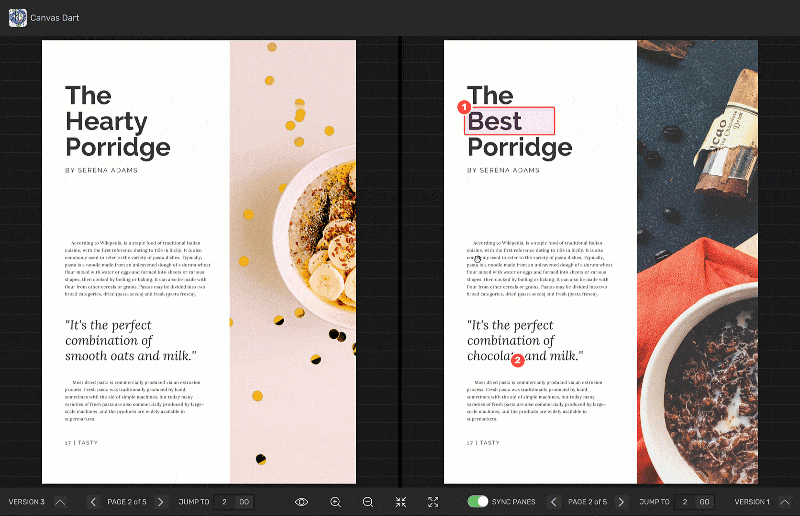
GoVisually is an online proofing platform that can help you streamline the review process and make collaboration among team members a breeze.
GoVisually allows you to upload and share designs with your team for feedback and approval. It also lets you track changes, leave comments, and give approvals in one centralized platform.
With GoVisually, you no longer have to worry about sending multiple emails with different versions of your designs or gathering feedback from various team members. The tool’s intuitive interface and collaboration features ensure everyone is on the same page and changes are made in real time.
The automation features let you set up approval workflows that automatically route designs to the right people for review and feedback, saving you even more time and effort!
So, if you’re a marketing or creative agency looking to automate your marketing workflow, GoVisually is the perfect solution!
Final word
Trust me; no one understands the stress of automation better than a content marketer!
We spend hours (sometimes days) debating how the work processes can be simpler and more effective.

Ease and accessibility should always be at the heart of your business. That will earn your team time to research more into working on the product or core services rather than spending hours doing things that can be easily automated.
Besides, seemingly tedious tasks can often take hours and leave you drained. This is why it is absolutely necessary to automate marketing workflows wherever possible. This gives you more time to build processes and focus on other work areas.
In this article, I’ve explored the 8 processes that can be automated to achieve a successful marketing campaign. Let me know your thoughts on this.
